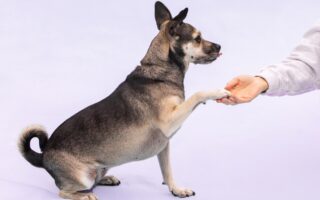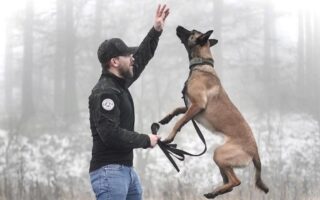Title: Mastering Canine Communication: Easy Tricks to Teach Your Dog in One Day
Introduction:
Imagine the joy of watching your dog proudly execute a new trick, its tail wagging with excitement as it eagerly awaits your praise. Teaching your furry friend new skills doesn’t have to be a time-consuming endeavor reserved for seasoned trainers. In fact, with a little patience and a dash of creativity, you can teach your dog several fun and practical tricks in just one day! Whether you’re a new dog owner or a seasoned pet parent looking to deepen your bond with your canine companion, this article will explore simple, effective methods that cater to various learning styles. From classic commands to playful antics, you’ll discover that with the right approach, your dog can add a little sparkle to its repertoire and perhaps impress your family and friends along the way. Get ready to unleash your training potential and enjoy a day filled with wagging tails and happy barks!
Table of Contents
- Effective Communication Techniques for Fast Learning
- Engaging Activities to Keep Your Dog Interested
- Positive Reinforcement Methods That Work Wonders
- Practical Tips for Consistent Training Success
- Q&A
- Future Outlook
Effective Communication Techniques for Fast Learning
To effectively teach your dog new tricks, it’s essential to communicate clearly and concisely. Use consistent cues—both verbal commands and hand signals are key. For instance, if you’re training your dog to sit, always use the same word, such as “Sit,” along with a clear hand gesture. This helps the dog associate the sound and motion with the action. Pair your commands with positive reinforcement, such as treats or praise, to create a strong incentive for learning. The consistency in cues and rewards builds a reliable learning pattern.
Incorporate short training sessions to maintain your dog’s attention and enthusiasm. Aim for 5-10 minute sessions, focusing on one trick at a time. This practice helps prevent frustration for both you and your canine. You can also utilize visual aids, such as helping your dog follow a treat into position while encouraging the desired behavior. Incorporating these techniques will accelerate the learning process and create a fun atmosphere for both you and your furry friend. Remember that patience and love are as crucial as the techniques themselves.
Engaging Activities to Keep Your Dog Interested
Teaching your dog tricks can transform a mundane day into an exhilarating experience filled with mental stimulation. Start with simple commands that can easily become playful activities. Try teaching your dog to shake or high-five, which not only showcases their skills but also deepens the bond you share. As your furry friend masters these tricks, add a twist and turn them into mini-games: a friendly competition of “who can do it faster?” will keep their tail wagging and their mind engaged. Consider incorporating these activities:
- Hide and Seek – Have your dog stay while you hide, then call them to find you.
- Treasure Hunt - Hide treats around your home or yard for a delightful scavenger adventure.
- Obstacle Course – Set up chairs, boxes, and tunnels for your pet to navigate through.
Another excellent way to keep your dog engaged is to teach them new tricks in quick succession. For instance, after mastering ‘sit’ and ‘stay’, challenge them to ‘roll over’ or ‘play dead.’ To spice things up, you can keep track of their progress using a simple training chart. This not only allows you to see their improvement but also motivates you to keep training consistently. Here’s a sample chart to visualize your dog’s learning journey:
| Trick | Status | Notes |
|---|---|---|
| Shake | ✅ Mastered | Perfected with treats |
| Roll Over | ⚪ In Progress | Needs more practice |
| Play Dead | ❌ Not Started | Next on the list! |
Positive Reinforcement Methods That Work Wonders
Using positive reinforcement techniques can transform training sessions into enjoyable experiences for both you and your dog. Celebrating small victories is essential, so always remember to reward desired behaviors immediately. This can be done through:
- Verbal praise: Use an enthusiastic tone to let your dog know they’ve done well.
- Delicious treats: Small, tasty rewards are great motivators.
- Playtime: Nothing beats the joy of a good game with their favorite toy.
Consistency is key! Make sure everyone in your household uses the same cues and rewards to avoid confusion. Consider creating a simple training chart to track your dog’s progress. This could include:
| Command | Success Rate | Next Steps |
|---|---|---|
| Sit | 90% | Add duration |
| Stay | 70% | Increase distance |
| Come | 50% | Practice in the yard |
This method not only keeps you organized but also helps build a strong bond with your furry friend, making training a fun and rewarding journey.
Practical Tips for Consistent Training Success
Consistency is the cornerstone of effective training. To ensure that your dog retains new tricks, incorporate short, focused training sessions throughout the day. Aim for intervals of about 5 to 10 minutes, allowing your dog to absorb the information without getting bored or overwhelmed. Frequent, little bursts of learning help to reinforce positive behavior and make training a fun experience for both of you. Utilize everyday moments to practice — for instance, have your dog “sit” before meals or “stay” before opening the door. This transforms routine occurrences into training opportunities.
Another critical element in achieving training success is utilizing positive reinforcement techniques. Reward your dog with treats, praise, or playtime every time they correctly perform a learned command. Here’s a quick reference table to illustrate various rewards you can use:
| Reward Type | Example |
|---|---|
| Treats | Small, tasty bites of kibble |
| Praise | Cheerful and enthusiastic verbal affirmations |
| Playtime | A quick game of fetch or tug-of-war |
Always remember to let your dog know they’ve done a great job. Keeping your sessions upbeat, patient, and encouraging will foster a love for learning, making your dog excited to engage with you every day.
Q&A
Q&A: Easy Tricks to Teach Your Dog in One Day
Q1: What are some simple tricks I can teach my dog in just one day?
A1: There are several fun and easy tricks that you can teach your dog within a single day! Some popular options include “Shake Hands,” where your dog learns to lift their paw and touch your hand; “Roll Over,” a fun roll that will surely impress your friends; and ”Play Dead,” which involves your dog collapsing onto their side after an exaggerated “bang!” cue. These tricks not only entertain but also strengthen the bond between you and your furry friend.
Q2: What is the best way to start teaching my dog a new trick?
A2: To start teaching your dog a new trick, the key is patience and positive reinforcement. Begin in a quiet environment with minimal distractions. Use treats or a favorite toy as motivation to grab your dog’s attention. Break the trick down into smaller, manageable steps, and make sure to reward your dog immediately when they successfully perform a step. This will help them associate the action with a positive outcome.
Q3: How long should I train my dog each session?
A3: Keeping training sessions short and engaging is vital to maintaining your dog’s enthusiasm. Aim for sessions that last between 5 to 10 minutes, especially if your dog is still young or new to training. You can repeat these short sessions multiple times throughout the day to reinforce the trick without overwhelming your pet with prolonged training.
Q4: What if my dog isn’t getting the trick? Should I be worried?
A4: It’s normal for dogs to take time to grasp new tricks, so there’s no need to worry! Every dog learns at their own pace, and factors like age, breed, and prior training can influence their progress. If you notice that your dog is struggling, take a step back and simplify the task. Make sure you’re being patient and encouraging, and if necessary, take a break and try again later.
Q5: Are there any common mistakes to avoid while training my dog?
A5: Yes, there are a few common pitfalls to be aware of during training. First, avoid using negative reinforcement; instead, focus on rewarding positive behavior. Additionally, don’t rush the process – patience is key! Lastly, ensure that your training environment is conducive to learning; a calm area free from distractions will allow your dog to focus on you and the task at hand.
Q6: How can I make training more fun for my dog?
A6: To keep training sessions enjoyable, incorporate playtime and variety. Use toys as rewards and mix up your training tricks to prevent boredom. You can also try using interactive games where your dog has to think or act creatively, making learning feel more like play. Remember, enthusiasm is contagious; if you’re having fun, your dog will too!
Q7: Can I teach my dog multiple tricks in one day?
A7: While you can introduce multiple tricks in one day, it’s essential to focus on quality over quantity. Attempt to teach one or two new tricks thoroughly rather than overwhelming your dog with many at once. This approach not only helps your dog learn better but also enhances their confidence as they master each trick.
Training your dog can be a rewarding experience, and with these easy tricks and tips, you’ll both be having fun together in no time! Happy training!
Future Outlook
teaching your dog new tricks doesn’t have to be a long, arduous process. With just a sprinkle of patience, a dash of creativity, and these easy techniques, you can make the most of a single day to bond with your furry friend while expanding their skill set. Remember, every paw-fect performance is a step towards deeper trust and understanding between you and your canine companion. So gather your treats, find a comfortable space, and embark on this fun-filled journey together. Who knows? By the end of the day, you might just find yourself both the proud owner of a new trick and the keeper of cherished memories that will last a lifetime. Happy training!



